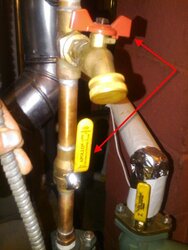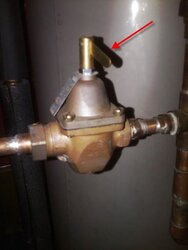Long story short, I had the furnace cleaned by some jackasses and I suspect there's a lingering problem. Without going into too much detail to the politics of it I'm left to fix it, myself.
I have an older, oil fired furnace or boiler. As I don't believe it has a tank I don't think it counts as a boiler, but whatever. It's got a bright red old style steel expansion tank. Downstairs, it seems fine. Upstairs the hot water doesn't seem to get to all the rooms. My sons room gets the most heat, when this thing kicks over it'll go from 60F to 80F in a matter of nothing flat. The master bedroom hardly gets any heat at all. I'm pretty sure, especially given the abuses it's suffered from the "technician", that it's got air in the lines. Now, the radiators in my folks house have bleeder valves. Air gets in there, you open the bleeder valve, stuff is once again happy. These are those "fin pipes" on the baseboard, they don't appear to have bleeder valves.
HOW DO I GET THE AIR OUT?
I read this: http://homerepair.about.com/od/heatingcoolingrepair/ss/trblsht_boiler_4.htm
It doesn't particularly describe my problem but it's something to check. I'm really at a loss as to how to get the air out though. I almost read it as "make sure it's at 12PSI and the air will enter the water" but this probably isn't how that works.
I have an older, oil fired furnace or boiler. As I don't believe it has a tank I don't think it counts as a boiler, but whatever. It's got a bright red old style steel expansion tank. Downstairs, it seems fine. Upstairs the hot water doesn't seem to get to all the rooms. My sons room gets the most heat, when this thing kicks over it'll go from 60F to 80F in a matter of nothing flat. The master bedroom hardly gets any heat at all. I'm pretty sure, especially given the abuses it's suffered from the "technician", that it's got air in the lines. Now, the radiators in my folks house have bleeder valves. Air gets in there, you open the bleeder valve, stuff is once again happy. These are those "fin pipes" on the baseboard, they don't appear to have bleeder valves.
HOW DO I GET THE AIR OUT?
I read this: http://homerepair.about.com/od/heatingcoolingrepair/ss/trblsht_boiler_4.htm
It doesn't particularly describe my problem but it's something to check. I'm really at a loss as to how to get the air out though. I almost read it as "make sure it's at 12PSI and the air will enter the water" but this probably isn't how that works.



